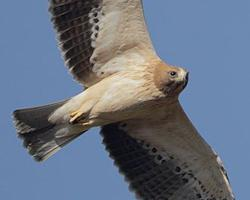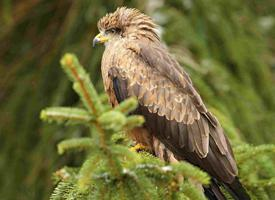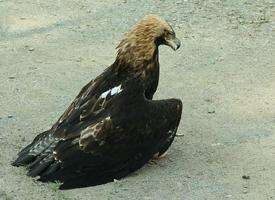
Statut de conservation
| Menacé |
Description de l'animal
The Booted Eagle (Hieraaetus pennatus) is a captivating bird of prey, known for its remarkable agility in flight and its striking appearance. This relatively small eagle belongs to the family Accipitridae, which includes hawks, eagles, and kites. It has a widespread distribution, found across Europe, Asia, and parts of Africa, showcasing its adaptability to various habitats.Measuring between 45 to 55 cm in length with a wingspan of 110 to 135 cm, the Booted Eagle is a medium-sized raptor. It exhibits sexual dimorphism, with females being slightly larger than males, a common trait among birds of prey. This eagle has two distinct color morphs, light and dark, adding to its intrigue. The light morph has a predominantly pale underbelly with dark streaks, contrasting with its darker upper parts. The dark morph, on the other hand, is mostly uniform dark brown, with slightly paler underwing coverts.
One of the most distinguishing features of the Booted Eagle is its "boots" – feathers that extend down the legs to the feet, a characteristic that has earned it its name. Its head is relatively small with keen, piercing eyes that reflect its adept hunting skills. The eagle's beak is hooked and powerful, designed for tearing flesh, while its talons are sharp and strong, enabling it to grasp its prey with precision.
The Booted Eagle is a versatile hunter, preying on a wide variety of small mammals, birds, reptiles, and insects. It often hunts from a perch or while soaring, utilizing its excellent vision to spot potential prey. Once a target is sighted, the eagle swoops down with incredible speed and agility to capture it.
During the breeding season, which typically spans from April to July, the Booted Eagle showcases remarkable nesting behavior. It builds its nest high in trees or on cliff ledges, often returning to the same site year after year. The nest is constructed with sticks and lined with green leaves, creating a secure and comfortable space for its eggs. The female usually lays 1 to 2 eggs, which both parents then incubate for about 37 to 41 days. The chicks are altricial, meaning they are born relatively undeveloped and are dependent on their parents for food and protection. The young eagles fledge around 45 to 55 days after hatching but may remain with their parents for an additional period before becoming fully independent.
Migration is a significant aspect of the Booted Eagle's life cycle. Birds breeding in Europe and northern Asia migrate long distances to winter in Africa and southern Asia, showcasing remarkable endurance and navigational skills. During migration, they can often be seen soaring on thermals, utilizing updrafts to cover vast distances with minimal energy expenditure.
Conservation-wise, the Booted Eagle is currently classified as being of Least Concern by the International Union for Conservation of Nature (IUCN), indicating that it does not face any immediate threats of extinction. However, habitat destruction, pesticide use, and changes in prey availability due to human activities could potentially impact its populations in the future. Conservation efforts aimed at preserving natural habitats and ensuring sustainable practices are crucial for the continued survival of this remarkable eagle.
In conclusion, the Booted Eagle is a fascinating and adaptable bird of prey, with its distinctive appearance, remarkable hunting skills, and intriguing behaviors making it a subject of interest for birdwatchers and conservationists alike. Its presence across diverse landscapes highlights the importance of maintaining healthy ecosystems to support the rich biodiversity of our planet.
Carte de répartition

Animaux similaires
Nouvelles photos d'animaux
Top 10 des animaux
- Dolphin gull (Leucophaeus scoresbii)
- Diana monkey (Cercopithecus diana)
- Moustached guenon (Cercopithecus cephus)
- Galápagos tortoise (Geochelone nigra complex)
- Japanese macaque (Macaca fuscata)
- Russian tortoise (Testudo horsfieldii)
- Stone loach (Barbatula barbatula)
- Greek tortoise (Testudo graeca)
- Common flying dragon (Draco volans)
- Vendace (Coregonus albula)


